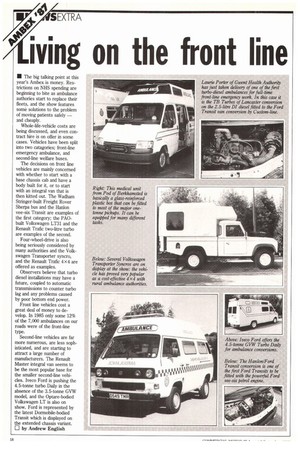wing on the front line
Page 20

If you've noticed an error in this article please click here to report it so we can fix it.
• The big talking point at this year's Arnbex is money. Restrictions on NHS spending are beginning to bite as ambulance authories start to replace their fleets, and the show features some solutions to the problem of moving patients safely — and cheaply.
Whole-life-vehicle costs are being discussed, and even contract hire is on offer in some cases. Vehicles have been split into two catagories; front-line emergency ambulance, and second-line welfare buses.
The decisions on front line vehicles are mainly concerned with whether to start with a base chassis cab and have a body built for it, or to start with an integral van that is then kitted out. The Wadham Stringer-built Freight Rover Sherpa bus and the Hanlon vee-six Transit are examples of the first category; the PAObuilt Volkswagen LT31 and the Renault Trafic two-litre turbo are examples of the second.
Four-wheel-drive is also being seriously considered by many authorities and the Volkswagen Transporter syncro, and the Renault Trafic 4x4 are offered as examples.
Observers believe that turbo diesel installations may have a future, coupled to automatic transmissions to counter turbo lag and any problems caused by poor bottom end power.
Front line vehicles cost a great deal of money to develop. In 1985 only some 12% of the 7,000 ambulances on our roads were of the front-line type.
Second-line vehicles are far more numerous, are less sophisticated, and are starting to attract a large number of manufacturers. The Renault Master integral van seems to be the most popular base for the smaller second-line vehicles. Iveco Ford is pushing the 4.5-tonne turbo Daily in the absence of the 3.5-tonne GVW model, and the Optare-bodied Volkswagen LT is also on show. Ford is represented by the latest Dormobile-bodied Transit which is displayed on the extended chassis variant_ D by Andrew English








































































































